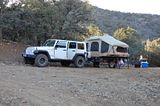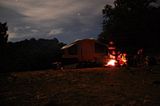I got them to build me a cover for mine right around the time you wrote this. I also got the spare tire and carrier, it's very well thought out just like the rest of the trailer. . As for going to larger tires, I bought mine thinking I would be doing that, but not real sure I need to. it has as much clearance as my stock JKU Rubi. A few offroad adventures will let me know if I need to fur sure. I probably will eventually, along with a different tongue. Wish I could see photos of RubiconGeoff's
Overall, I'm impressed with the sturdiness of the components and the apparently well-thought-out design. It went together like someone had put some effort into making the assembly straightforward.
Specific comments (from my experience, YMMV):
- The instructions are straightforward and step-by-step. Occasionally there is some ambiguity about what exactly is to be done, but a bit of study resolves it.
- I suggest assembly be done on as flat and level a surface as possible. It will reduce the amount of fiddling to get everything to line up in the end. There is not a lot of slop in how things can go together (a good thing, IMO).
- A hammer and block of wood is a good (for me, necessary) substitute for the recommended rubber mallet. In a few places, gentle persuasion with a tap of a sledge sorted things out.
- Mention of the sledge brings to mind the one area where I feel quality falls short:the two wood floor sections. If I was to do it again, I would just buy my own higher quality 2x6s and copy the supplied pieces. They were warped, split, and very uneven. I used deck screws to pull things tighter together and still had to shave a fair amount off both sides of both ends with a hand plane to get the flooring to fit (and apply the sledge to tuck the back end in the frame).
- I can post who made the axle, tongue, jack, tires, etc if anyone wants to know.
- The tent provides a huge amount of floorspace and bedspace for such a small trailer footprint (5x7). Another 2" of firm foam for the bedding will feel good to these old bones.
- I think the wheel bearings are unsealed. I remember helping Granddad grease his boat trailer wheel bearings in the 1960's - 50 years later and I will be doing it still.
- When locating for camping, you need to get the axle level (side to side). Then you can adjust front/rear height and set up the "wings" to work on uneven ground.
One person can do most of the assembly, but a second person sure helps a lot of the time, to provide someone on "the other end" or added muscle.
I think this thing will be just about bulletproof in a car camping application.
I'm still undecided about changing wheel/tire sizes. I sampled some trailer wheels and tires at TSC. The stock (no-name, Chinese I'm sure) wheel+tire combo weighs about 28 lbs. I think if I change anything it would be to go to a 14" wheel. 15"+ seems to add more weight than I care to have. 14" gives a wider variety of available tires with a similar load rating (in pounds, according to TireRack). I'd go to a wider tire - from 5.5" to 6.5" tread width. That's about the max that will fit in the stock fenders. And change from bias ply to radials, for the improved "ride".
I do think I'll go to a torsion bar fairly soon. I need to find someone locally who can spec the dimensions, or learn more about it myself. From what I can tell, there are bit players making trailer torsion bars, but Dexter dominates the market - so I would probably use them unless I find a strong reason not to.
I can't find the options mentioned in the manual at Lifetime - the spare tire and holder, the cargo cover, the storage cover. I'd like to get the storage cover. Maybe I should call them.
My main concern over the long haul is the tent. Lots of folks can keep the steel trailer going. The tent is probably not feasible to replace except from Lifetime. I thought about asking them if I can buy a complete second tent and keep it for spare parts or as a backup.


